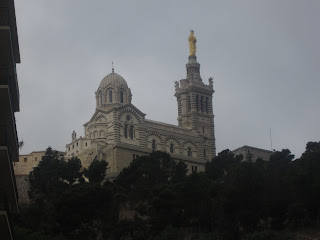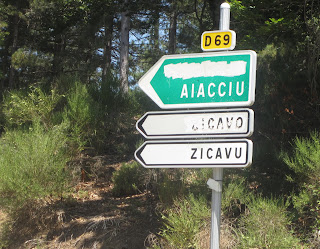Our journey from Ajaccio was uneventful enough, fortunately as it turned out. When our ferry docked at Toulon, we queued at the exit. We were prevented from leaving by the staff who, shortly after, admitted four of the local police to deal with four of our fellow passengers in relation to a “vol”. There was no information on what was stolen, from whom, how it was discovered or how the perpetrators were apprehended, but we were later pleased to recall that we had locked our cabin from the inside before sleeping peacefully on the calm Mediterranean for the passage to Toulon.
I have never been to Marseille, so all my impressions were formed by the media, in particular, movies. They always seemed dark, dangerous and ugly, and so my expectations of the city were not high. We decided to spend our last few days of the trip in Marseille for two reasons. Firstly, neither Dominique nor I had been to France’s second largest city and second, our train to Paris CDG on Tuesday was leaving from Marseille, and so to stay anywhere else would require another change of hotel.
First impressions were positive. We found a hotel a short walk from the old port, took a walking tour around the area know as Le Panier, or the basket, which was named after a tavern which now no longer exists. I was surprised to find that, in order to limit hiding places for the members of the resistance, the German troops in 1942 demolished 3,000 homes in this area, which was the site of the old walled town. Combine this loss with the destruction of churches and royal buildings during the revolution and it is not surprising that the city was known as the ancient city with no signs of age.
Unfortunately, the museum of the ancient town, which is build around the archaeological findings which emerged with the construction of a shopping centre near our hotel, was closed for renovations. However the remains provide a physical link between modern Marseilles and the Greek and Roman ports established in the area.
 Further up the hill, the old town is undergoing a slow gentrification, after being mostly abandoned to the immigrant workers recruited for the port and the related industries when the new part of town was built on the other side of the old port in the 19th century.
Further up the hill, the old town is undergoing a slow gentrification, after being mostly abandoned to the immigrant workers recruited for the port and the related industries when the new part of town was built on the other side of the old port in the 19th century.We were delighted to find a small, new and creative museum devoted to the French national anthem, which of course, was the song of a regiment from Marseille which became the theme of the revolution.
They got a little carried away with the toilet design.
After the first good impressions, there were a few bad impressions which followed. Urine – it seems that every man in town pisses just about anywhere he wants, and is proud to leave his scent for following alpha males to recognise and try to obliterate with their own piss. Garbage – it seems that, in spite of a good supply of rubbish bins on the street, it is more acceptable to just throw stuff on the ground. Sewer smells – around every corner. I find it hard to understand how a society that can produce the glorious fountains of Versailles, the canal du midi and provide the world with two of the major water supply and treatment companies internationally, cannot seem to manage to get the sewer right at home - but they can’t.
My final bad taste came from one of the most recognisable structures in Marseilles, the Basilica of Norte Dame de la Garde.
 |
| Not subtle |
NDLG in on the hill to the South of the city and is one of the basilicas built during the 18th century along with, for example, a similar monstrosity overlooking the otherwise beautiful city of Lyon. The structure sets out to be imposing with a huge statue of Mary carrying the baby Jesus on top of the church. The diameter of the arm of the baby is 1.1metres, so you can judge the size of the rest. The church is horrendously over decorated with gold, sparkles, stained glass and statues richly covered in every spare space in the building, and that is bad enough.
 |
| Some views of the interior NDLG |
The official claims of the church, set out carved in marble for all to see, include the protection of Marseille from destruction during the second world war (see above, apparently the protection does not extend to the poor areas), and the eventual liberation of the town. One of the personal messages was a thank you for winning the Tour de France and for assistance with the struggle against drugs in the following months. I wonder how NDLG chose who to support, why she supported a drug cheat and why she did not support anyone the following year.
These concerns are all trite, but we did visit around 11.45 while the Sunday mass was underway in the Crypt. We noted that there was a café upstairs, and so made our way up for a bracing coffee prior to the walk down the hill. We found ourselves in a restaurant, with sufficient seats for 50 to 70 people, all reserved. We watched the congregation wend its way up to the restaurant and take their places, to be served by several young women in what looked like representative dress, if not national dress, from a range of poor, third world countries. They were polite, respectful and hard working (the young women, not the congregation)– meeting the needs of the good (catholic) burghers of the parish of NDLG. A conversation with one of the young women, in perfect French, confirmed my suspicions. The best and brightest young women of Africa and Asia had devoted their youth to becoming novices of the order of nuns who had their headquarters at NDLG. Their vocation was to feed the hungry masses, after mass, with the plat du jour.
France, the eldest sister of the church, is sometimes the ugly sister.




























